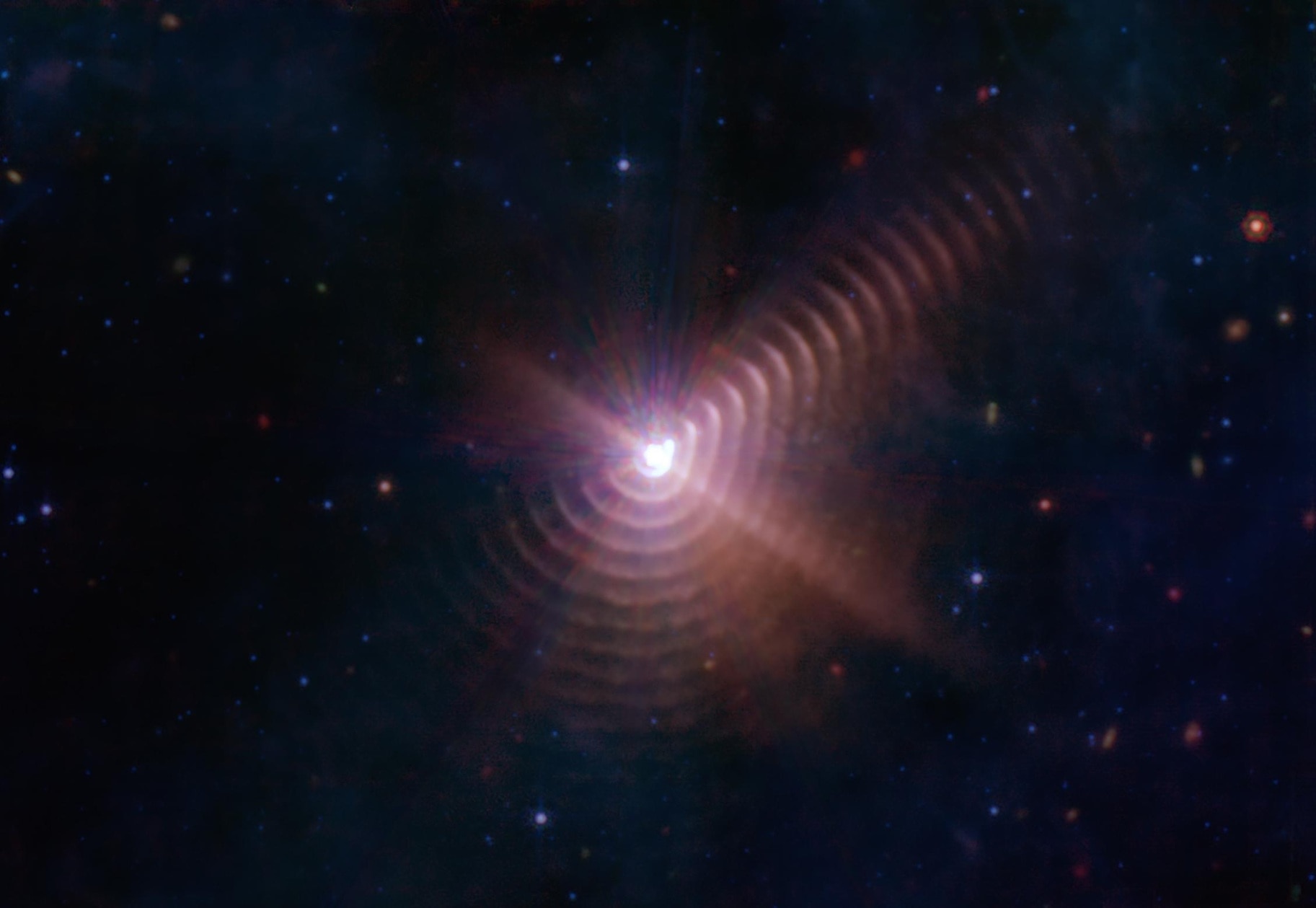Create a free profile to get unlimited access to exclusive videos, sweepstakes, and more!
JWST captures lightyear-wide dust rings around dying binary star
Over a century of time is written across the sky.

In the 1988 science fiction film They Live (now streaming on Peacock!) humanity is in the midst of a quiet alien invasion. Malicious extraterrestrials are masquerading as people and using subliminal messages to control the population. And they might have gotten away with it too, if it weren’t for Nada — played by Roddy Piper — and a pair of truth-revealing sunglasses. Putting on the sunglasses revealed a different view of the world, one in which some things were muted while others were made startlingly clear.
There’s a similar principle at work, although hopefully with fewer species-threatening consequences, in the field of infrared astronomy. As we attempt to catch imagery of objects incredibly far away, we find that their light has shifted toward and into the infrared, beyond the ability of our natural sight. Infrared telescopes, however, allow us to see into those bands to reveal previously invisible structures in the universe. There’s plenty of interesting stuff out there for us to see, but you can only see them if you’re wearing the right sunglasses, so to speak.
That’s why the JWST is so exciting to so many astronomers. It’s the most powerful infrared telescope we’ve ever built, and it has the added benefit of being in space. “Infrared astronomy is super hard to do from the ground because the wavelengths we need are absorbed by Earth’s atmosphere and the atmosphere is also emitting infrared photons. That’s why being in space, JWST gives us that huge advantage of not having to worry about the atmosphere interfering with our observations,” astronomer Ryan Lau told SYFY WIRE.
Lau is an astronomer at DSF’s NOIRLab and the lead author of a new study published in the journal Nature Astronomy. He, along with colleagues, pointed the JWST at an object in space known as Wolf-Rayet 140, a binary star system surrounded by layers of constantly expanding dust. We’ve known about WR-140 for decades, but we’ve always been limited in how well we could see it, which also limited how well we could understand it.
WR-140 is made up of two O type stars, a class of star which is among the largest in the universe. One of them is still in the main phase of its life while the other is in the process of dying. That unique set of conditions makes for some interesting interactions as the stars’ orbits bring them nearer to one another and farther away.
As O type stars die and move into this Wolf-Rayet phase of their lives, they start releasing massive amounts of material. Their outer hydrogen shell is mostly eroded away, and the hotter and more chemically complex interior is revealed. Usually, Wolf-Rayet stars simply shed their gasses in a sort of shell which expands out around them. The gas is too hot for it to resolve itself into solid material and instead blooms outward from the star at its center, pushed onward by stellar winds. Something weird and wonderful happens though, when you give a Wolf-Rayet star a friend.
“Most Wolf-Rayet stars don’t form dust because they are so hot and extreme. Seeing one form dust is almost like seeing ice form in an oven. What seems to be key is a binary companion and colliding winds. It’s the compression of that material that allows you to achieve the conditions for dust formation” Lau said.
As the stars orbit, they’re both shedding material and pushing it out with the stellar wind. The Wolf-Rayet star’s winds are, admittedly, considerably stronger. When their orbits bring them into proximity with one another, their two winds crash into each other and condense. Then the orbits continue onward, and things settle down.
“When the winds collide, you actually get something that’s really hot. You have two winds traveling thousands of kilometers a second smashing into one another. Then, as it flows outward it cools from being millions of degrees down to a thousand degrees. That’s when the dust formation can occur,” Lau said.
Those close passes between the two stars of WR-140 happen roughly every eight years. When they do, they build up a new layer of condensed material which starts its journey away from the system. Eventually it cools enough that it forms into a ring of dust slowly spreading away. In fact, they aren’t rings but shells, spreading out in every direction like a slowly expanding balloon. But seen from Earth — or rather from an orbiting telescope at one of Earth’s Lagrange points — they look like rings, each one marking the passage of eight years in the last stage of a distant star’s life.
The new image reveals 17 rings, stretching more than 80,000 times the distance from the Earth to the Sun. These 17 rings represent more than a century of cosmic time, and it’s likely there are many more rings which were too faint for us to see, even with the JWST. According to Lau, the Wolf-Rayet phase of an O type star’s life can last anywhere from 10,000 to 100,000 years, and there’s really no telling where we are within that process. It’s likely WR-140 will continue to produce rings well beyond our lifetimes and has probably been producing rings for thousands of years. There are countless additional dust shells, each of which traces the history of WR-140 back to moment when one of the stars started to die.
Death is, unfortunately, something which comes for all things, even stars and universes. One can only hope that billions of years from now, when the time comes for our own star, there’s someone out there to take some nice pictures.


























